Sorghum: Diseases and Symptoms
Sorghum: Diseases and Symptoms
Sorghum grain mould
Damage symptom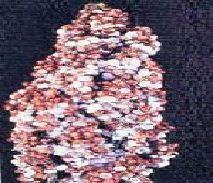 If rains occur during the flowering and grain filling stages, severe grain moulding occurs. The most frequently occurring genera are Fusarium, Curvularia, Alternaria, Aspergillus and Phoma. Fusarium semitectum and F.moniliforme develop a fluffy white or pinkish coloration. C. lunata colours the grain black. Symptom varies depending upon the organism involved and the degree of infection.
If rains occur during the flowering and grain filling stages, severe grain moulding occurs. The most frequently occurring genera are Fusarium, Curvularia, Alternaria, Aspergillus and Phoma. Fusarium semitectum and F.moniliforme develop a fluffy white or pinkish coloration. C. lunata colours the grain black. Symptom varies depending upon the organism involved and the degree of infection.
- The fungi mainly spread through air-borne conidia.
- The fungi survive as parasites as well as saprophytes in the infected plant debris.
- Wet weather following the flowering favors grain mould development.
- The longer the wet period the greater the mould development.
- Compact ear heads are highly susceptible.
Sorghum charcoal rot
Damage symptom- Charcoal rot is a major disease in the dry sorghum growing regions. The disease is particularly destructive on high yielding, sorghum that mature during hot and dry weather if the vigorously growing crop is subjected to moisture stress during the pre-flowering period. Infected stalks show an internal shredding at and above the ground line. The shredding can be observed by splitting the stalk and molting the deteriorated soft pith tissue leaving the tougher vascular strands
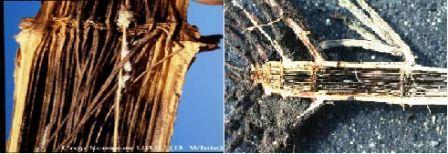
- Survival of microsclerotia is several years in dry soil but only a few weeks in wet, saturated soils.
- Charcoal rot is caused by Macrophomi naphaseolina, a disease that appears in hot and dry weather.
- When soil temperatures are 80-95°F (27-35°C) for 2 to 3 weeks.
Sorghum downy mildew
Damage symptom- The fungus causes systemic downy mildew of sorghum. It invades the growing points of young plants, either through oospore or conidial infection. As the leaves unfold they exhibit green or yellow colouration. Abundant downy white growth is produced on the lower surface of the leaves, which consists of sporangiophores and sporangia. Normally three or four leaves develop the chlorotic downy growth. Subsequent leaves show progressively more of a complete bleaching of the leaf tissue in streaks or stripes. As the infected bleached leaves mature they become necrotic and the interveinal tissues disintegrate, releasing the resting spores (oospores) and leaving the vascular bundles loosely connected to give the typical shredded leaf symptom.
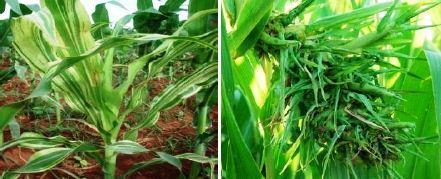
- The primary infection is by means of oospores present in the soil which germinate and initiate the systemic infection.
- Secondary spread is by air-borne sporangia
- Maximum sporulation takes place at 100 per cent relative humidity.
- Optimum temperature for sporulation is 21-230C during night.
- Light drizzling accompanied by cool weather is highly favourable.
Sorghum anthracnose
Damage symptom- The fungus causes both leaf spot (anthracnose) and stalk rot (redrot). The disease appears as small red coloured spots on both surfaces of the leaf. The centre of the spot is white in colour encircled by red, purple or brown margin. Numerous small black dots like acervuli are seen on the white surface of the lesions. Red rot can be characterized externally by the development of circular cankers, particularly in the inflorescence. Infected stem when split open shows discoloration, which may be continuous over a large area or more generally discontinuous giving the stem a marbeled appearance.
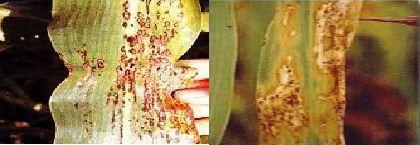
- The disease spread by means of seed-borne and air-borne conidia and also through the infected plant debris.
- Continuous rain.
- Temperature of 28-30˚C.
- High humidity.
Loose smut
Damage symptom- The affected plants can be detected before the ears come out. They are shorter than the healthy plants with thinner stalks and marked tillering. The ears come out much earlier than the healthy. The glumes are hypertrophied and the earhead gives a loose appearance than healthy. The sorus is covered by a thin membrane which ruptures very early, exposing the spores even as the head emerges from the sheath.
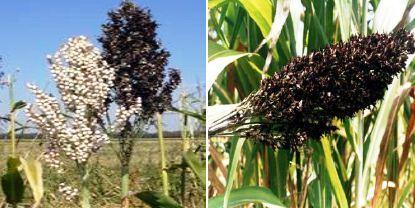
- The pathogen is externally seed borne.
- Optimum environmental conditions for maximum infection include: temperatures between 20 and 25°C and slightly acidic soils favour the disease developments.
Rust
Damage symptom- The fungus affects the crop at all stages of growth. The first symptoms are small flecks on the lower leaves (purple, tan or red depending upon the cultivar). Pustules (uredosori) appear on both surfaces of leaf as purplish spots which rupture to release reddish powdery masses of uredospores. Teliopores develop later sometimes in the old uredosori or in telisori, which are darker and longer than the uredosori. The pustules may also occur on the leaf sheaths and on the stalks of inflorescence.
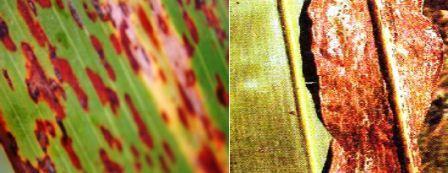
- The uredospores survive for a short time in soil and infected debris. Presence of alternate host helps in perpetuation of the fungus.
- Low temperature of 10 to 120C favours teliospore germination.
- A spell of rainy weather favours the onset of the disease.
Ergot
Damage symptom- The disease is confined to individual spikelets. The first symptom is the secretion of honey dew from infected florets. Under favourable conditions, long, straight or curved, cream to light brown, hard sclerotia develop. Often the honey dew is colonised by Crerebella sorghivulgaris which gives the head a blackened appearance.
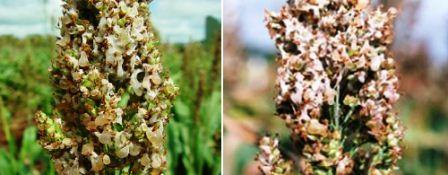
- The primary source of infection is through the germination of sclerotia which release ascospores that infect the ovary.
- The secondary spread takes place through air and insect-borne conidia. Rain splashes also help in spreading the disease.
- A period of high rainfall and high humidity during flowering season.
- Cool night temperature and cloudy weather aggravate the disease.
IPM for Sorghum
To know the IPM practices for Sorghum, click here.
Source: NIPHM and Directorate of Plant Protection, Quarantine & Storage
Last Modified : 4/2/2020
© C–DAC.All content appearing on the vikaspedia portal is through collaborative effort of vikaspedia and its partners.We encourage you to use and share the content in a respectful and fair manner. Please leave all source links intact and adhere to applicable copyright and intellectual property guidelines and laws.
RELATED ITEMS
Fig Diseases
This topic covers information about Fig Diseases.
Fenugreek Diseases
This topic covers information about Fenugreek Dis...
Blackgram & Greengram: Diseases and Symptoms
This topic covers the Information related to Disea...
Amla Diseases
This topic covers information about Amla Diseases ...
